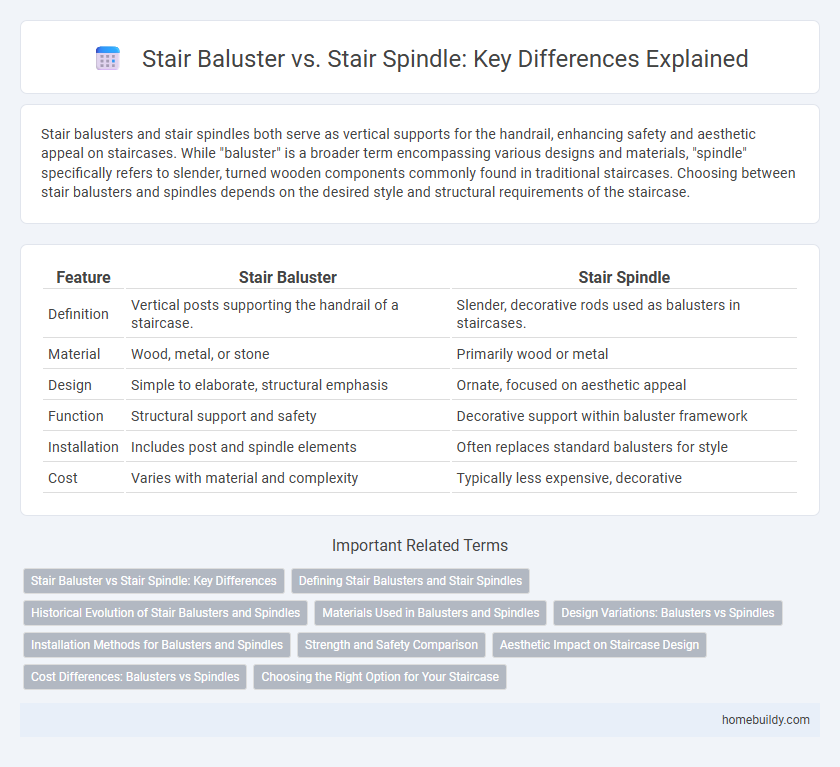Stair balusters and stair spindles both serve as vertical supports for the handrail, enhancing safety and aesthetic appeal on staircases. While "baluster" is a broader term encompassing various designs and materials, "spindle" specifically refers to slender, turned wooden components commonly found in traditional staircases. Choosing between stair balusters and spindles depends on the desired style and structural requirements of the staircase.
Table of Comparison
| Feature | Stair Baluster | Stair Spindle |
|---|---|---|
| Definition | Vertical posts supporting the handrail of a staircase. | Slender, decorative rods used as balusters in staircases. |
| Material | Wood, metal, or stone | Primarily wood or metal |
| Design | Simple to elaborate, structural emphasis | Ornate, focused on aesthetic appeal |
| Function | Structural support and safety | Decorative support within baluster framework |
| Installation | Includes post and spindle elements | Often replaces standard balusters for style |
| Cost | Varies with material and complexity | Typically less expensive, decorative |
Stair Baluster vs Stair Spindle: Key Differences
Stair balusters are vertical posts that support the handrail and provide structural integrity, while stair spindles are typically thinner and more decorative elements within the baluster system. Balusters are often made from wood, metal, or composite materials and focus on strength and safety, whereas spindles emphasize aesthetic appeal and can include intricate designs. Understanding the key differences helps in selecting the right component for both functional support and visual style in staircase construction.
Defining Stair Balusters and Stair Spindles
Stair balusters are vertical posts that support the handrail and provide structural stability to a staircase, typically made from wood, metal, or glass. Stair spindles are a type of baluster characterized by their slender, turned design often used for decorative purposes in traditional staircases. Understanding the distinction helps in selecting the appropriate style for both safety and aesthetic appeal in stair design.
Historical Evolution of Stair Balusters and Spindles
Stair balusters and spindles have evolved significantly since the Renaissance, with balusters originally crafted as ornate, turned wooden or stone elements symbolizing architectural refinement. Over centuries, spindles, often simpler and slimmer, emerged as functional components focusing on support and safety in stair design. The distinction between decorative balusters and practical spindles reflects changing stylistic trends and advances in woodworking and metalworking techniques throughout history.
Materials Used in Balusters and Spindles
Stair balusters and spindles are often made from similar materials, including wood, metal, and fiberglass, but the choice influences durability and aesthetics. Wooden balusters offer classic appeal and can be crafted from hardwoods like oak or maple, while metal options such as wrought iron provide strength and a modern look. Fiberglass balusters are valued for their resistance to moisture and insects, making them ideal for outdoor staircases or humid environments.
Design Variations: Balusters vs Spindles
Stair balusters offer a wide range of design variations, typically featuring ornamental shapes, intricate carvings, and diverse materials such as wrought iron, wood, and metal alloys. Stair spindles are generally simpler, slender, and more uniform in style, often emphasizing functionality over elaborate design. Choosing between balusters and spindles depends on the desired aesthetic and architectural style, with balusters providing more decorative options and spindles offering a minimalist, traditional look.
Installation Methods for Balusters and Spindles
Stair balusters and spindles differ primarily in installation techniques, with balusters typically secured by drilling into the stringer or tread and using wood glue or screws for stability. Spindles are often installed through pre-drilled holes on the handrail and tread, relying on tight-fit dowels or metal fasteners to maintain alignment and support. Choosing the appropriate installation method depends on stair design, material, and desired structural strength.
Strength and Safety Comparison
Stair balusters, often constructed from robust materials like wrought iron and hardwood, provide superior strength compared to thinner stair spindles commonly made from lightweight wood or metal. The increased thickness and durable composition of balusters enhance the overall safety of stair railings by offering greater resistance to impact and reducing the risk of breakage. Stronger stair balusters ensure compliance with building codes that demand secure handrails for preventing falls and providing stable support.
Aesthetic Impact on Staircase Design
Stair balusters and stair spindles both significantly influence the aesthetic impact of staircase design by providing structural support and visual appeal, yet balusters tend to offer a more substantial and elaborate presence due to their diverse materials and intricate shapes. Balusters, often crafted from wood, metal, or wrought iron, enhance sophistication and style, creating stately or modern impressions depending on the design choice. In contrast, stair spindles, usually slender and simpler, contribute to a lighter, more delicate look, favoring minimalist or traditional aesthetics.
Cost Differences: Balusters vs Spindles
Stair balusters typically cost more than stair spindles due to their heavier materials and intricate designs, with prices ranging from $15 to $50 per baluster compared to $5 to $20 per spindle. Balusters often use materials such as wrought iron, wood, or metal, contributing to higher manufacturing and installation expenses. Spindles, generally made from lighter materials like wood or metal, offer a budget-friendly alternative ideal for standard residential staircase designs without sacrificing aesthetic appeal.
Choosing the Right Option for Your Staircase
Stair balusters and stair spindles both serve as vertical supports for the handrail, but selecting the right option depends on style, material, and structural needs. Balusters typically offer sturdier support and come in various materials such as wood, metal, or wrought iron, while spindles tend to be more decorative and lightweight, ideal for traditional or modern aesthetics. For safety and durability, balusters are preferred in high-traffic areas, whereas spindles suit decorative staircases requiring a more intricate design.
stair baluster vs stair spindle Infographic

 homebuildy.com
homebuildy.com